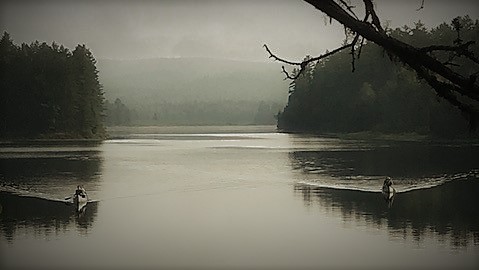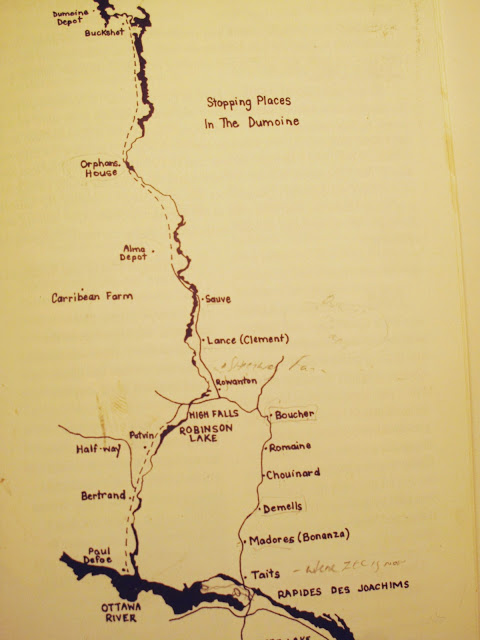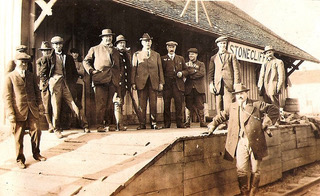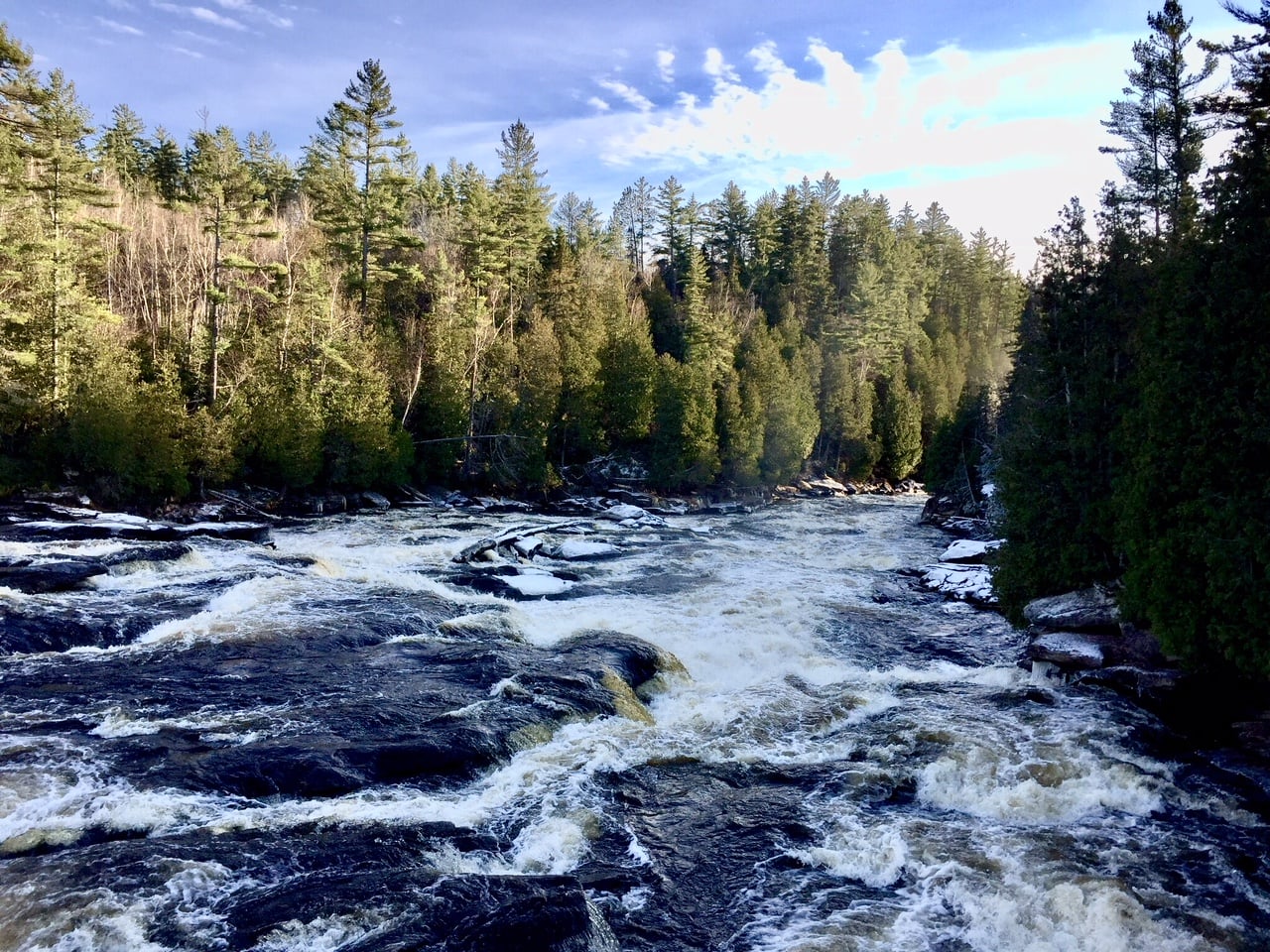Dumoine Tote Road History
A River with a storied past

The Dumoine has been an important trade route and meeting place for many First Nation peoples for centuries. The Ottawa River watershed is the ancestral home of the Algonquin Nation, and the Dumoine was the home of the Dumoine River Families of that nation. This group of 12 families created the first portages and hunting trails in the watershed. Later, the Dumoine and its surrounding areas would become important to European colonizers as a logging river and fertile valley.
A timeline of the Dumoine's natural and human history
10,000 years ago
The mouth of the Dumoine river lies submerged beneath the northern limit of the Champlain Sea.
5000 to 8000 years ago
Ancestors of the Anishinaabe live thirty kilometers upriver at what is now known as Morrison Island and trade with nomadic tribes travelling by foot or canoe up and down the Dumoine.
1000 to 2000 years ago
Algonquin families claim or are assigned by communal law the Dumoine River as their territory. Together they identify each family’s hunting territory of 500-1000 square miles, the limits defined by significant natural features.
1000 to 500 years ago
Summer travel by the families to harvest natural bounties like berries, waterfowl, birchbark and fish -especially eels - and to trade, socialize, and meet as a tribe during the open water season, takes them on trips up and down the Dumoine and Ottawa rivers.
1500-1600 AD
Contact with Europeans (Cartier and Basque fishermen) is first made in the Gulf of St Lawrence in the 1500s. Word and trade goods would have reached the powerful Morrison Island family known as The Kitchissippirini not long afterwards. Their Chief ‘Tessouat’ along with other chiefs, meet with Samuel De Champlain at the Gulf in 1603.
1600-1700
Early French traders recognize the trade potential of the Dumoine on their way to establish a fort on Lac Temiscamingue. Trade and travel are severely interrupted by the Beaver Wars involving the Haudennaussonee (five nation Iroquois) and the Anishnabe and Wyandot/Wendat (Huron) peoples.
1600-1700
The original post on Lac Temiscamingue and the village on Morrison Island are destroyed by Seneca Warriors during this period. European explorers, soldiers and priests join the traders passing by, sometimes stopping at the Dumoine in the 1600s.
1700-1800
After the great Peace Treaty signed in Montreal ended the Beaver wars, French merchant Paul Guillet purchases the trade licence for the Ottawa River watershed. He builds a new Fort Temiscamingue at the narrows, where it still exists today, and temporary posts at Grande Lac Victoria, Lac Dumoine and the mouth of the Dumoine. Trade goods are carried to Temiscamingue in the large 36-foot canoes and to the outposts in the smaller 26-foot canoes. The Dumoine families would have seen, traded, built, and even crewed a lot of these canoes.
1759
Alexander Henry the Elder, a British Trader, stops to trade at the mouth of the Dumoine with a group of who he believes to be Swampy Crees (Maskegons - Mushkegowuk people) from the James Bay watershed.
1760-1794
Fort Temiscamingue is taken over by William Grant, an English trader from New York, and Richard Dobie, a Scottish Trader. They compete with the Hudson Bay Company and with other tribes to the west and the north for fur and territory.
1769
The independent Montréal traders merge to form the Northwest Company to compete with the Hudson Bay Company in the west.
1794
Grant and Dobie are invited to join the Northwest Company.
1821
The Hudson Bay Company merges with the Northwest Company. Sir George Simpson, the leader of the HCBo, moves their headquarters to Montreal. Relatives of Grant and Dobie would continue to be HBCo employees at Fort Temiscamingue.
1821
HBCo maintains posts at Fort William on the Ottawa, at Rapides-des-Joachims, a temporary spring post at the mouth of the Dumoine, and a post at Mattawa Fort Temiscamingue and Grande Lac Victoria. Dumoine Families traders visited each of these posts travelling up and down the river.
1840
Roderick Ryan and his son Roger begin cutting timber at the mouth of the Dumoine and build a two-mile road to the top of their limit.
1846
Thomas Keefer, Engineer for the Department of Public Works, builds a proper Timber Crib Slide at Rapides-des-Joachims, replacing a poorly constructed private effort in 1844. This greatly assists the movement of timber cut above the rapid. A similar slide or canal now existed at every rapid between the Dumoine and Quebec City.
1850
The Dumoine Boom and Slide Company, owned by logging companies operating on the Dumoine, builds river improvements including a boom at the mouth, several deflector side dams, a 300-foot slide past the first drop at Grande Chute, and a 25-km road from the mouth of the Dumoine to Grande Chute.
1854
The department of Public Works begins to sell mill rights on Chaudière Island. Within 5 years this revolutionized logging on the Dumoine by changing the type of logs required at the mills from giant squared timber to round 16-foot saw logs. This shortens the river drive for saw logs by three weeks. Square timber would still go to Quebec City until 1900. As consequence, logging expands to the top of Lac Dumoine.
1854
The steamer “Pontiac” is built and launched in Pembroke to serve the Ottawa River from Pembroke to Rapides-des-Joachims. This links Rapides-des-Joachims with Aylmer and Montreal with a series of steamers, canals, and stagecoaches bypassing each rapid.
1860
Duncan Sinclair surveys Aberdeen and Aberford Townships to allow the sale of 100-acre lots to settlers. This includes the area around the lower Fildegrand rapids and Grande Chute.
1866
The timber companies that used the Ottawa River to float their timber to the Ottawa Mills form the Upper Ottawa Improvement Company (ICO) with the goal of moving timber to market equitably (previously a very competitive procedure).
1871
The first census of the new Confederation of Canada takes place.
1877-1880
The steamer “Kippawa” is launched to link the upper landing at Rapides-des-Joachims to the south end of the Rocher Capitaine Portage Road. Wagons and steamers extended further up the Ottawa River to Mattawa by 1880.
Historical Sites
Sweezy/Dufoe Stopping Place
In 1858, the townships on the Upper Canada side of Rapides-des-Joachims (in what is now Ontario) were being surveyed for settlement as well as for the construction of a new road to link Pembroke to Mattawa. Soon afterwards, the steamer “Pontiac” began arriving daily from Pembroke, carrying workers and visitors up the Ottawa River to Rapides-des-Joachims. The area by the mouth of the Dumoine thrummed with activity as laborers walked up and down the tote road to reach the timber slide and perform other logging related tasks along the river.

By 1871, Rapides-des-Joachims had nearly doubled in population, and had grown to be a lively town. One notable resident of the time was Benjamin Sweezy, who, alongside his family, ran a large farm, an overnight stopping spot, and a shoemaker's shop at the mouth of the Dumoine. Sweezy’s application to host a post office on his property, however, was denied in 1875 by the postmaster general. The Sweezy farm was 400 acres total, and produced 100 bushels of barley, 20 of peas, and 200 of potatoes, as well as 23 tons of hay and 300 cords of wood every year. Sometime after 1876, Sweezy sold or leased his property and the businesses on it to Joseph Dufoe (born 1823) a laborer who specialized in stonemasonry. Joseph was married to Mary Simposon-Dufoe, and together they had a large family, with 12 children between them. By 1891, Paul Dufoe (born 1864), their middle child, had taken over operations at the farm and stopping place.

Bertrand Stopping Place
Paul Dufoe invested in a second stopping place at the mouth of the Fildegrand river, alongside his sister Cecilia and her husband Joseph Bertrand, who were named innkeepers in the census. Based on evidence still remaining at the site, the stopping place appeared to be large property, with a big bunk house and stable, and it operated well into the 1940s.

Potvin Stopping Place
In 1890, railroad access had reached the mouth of the Dumoine and with it brought sportsmen from Montreal and New England, who were interested in going to private hunting and fishing leases along the river. Looking to expand his operations and build new structures to take advantage of this new development, Paul Dufoe bought the Hawkesbury Farm Depot around 1895, but sold it off not soon afterwards, perhaps because it was simply too far away for him to practically operate. The farm depot is now known as the Dumoine Rod and Gun Club lodge. In 1918, founding members of the club hiked along the tote road to survey a large territory and to apply for a private club lease. They built their first lean-to cabin on Robinson Lake, soon followed by 7 more. Until the 1940s, they would hike into these cabins via the Dumoine Tote Road, staying at Dufoes, Bertrands and a third farm known as Main Camp, or Potvin’s farm.

Recently
In the 1900s the forest was patrolled by forest rangers watching for fires from a series of fire towers throughout the Dumoine Valley. The Tote road became the access route for these rangers and their fire fighting equipment. Lastly, a new breed of urban sportsmen, keen on the Dumoine hunting and fishing experience, walked up the Dumoine Tote Road to their cabins beginning in 1918. By 1960, air patrols by float planes were used to locate fires. Improved trucks and bush roads all replaced the forest rangers, the river drives and offered an alternative for the walk-in sportsmen.
The Tote Road was then abandoned to nature...Until now.
Thank you for learning about the trail's stories, it's time for you to go and help write the Dumoine Tote Road's new chapter by hiking the trail!